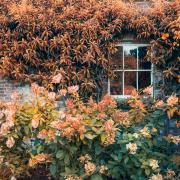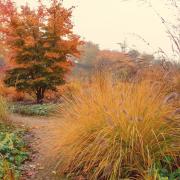The lush displays of May and June start to fade, July arrives, and a different vibe takes over the garden. The summer solstice has passed and light levels start to change to a reddish tint in the evenings and warm colours come into their own. July is the month where I simply sit and savour the warm evenings for as long as possible. In my village garden bats flit across the evening sky, the heady scents of herbs surround and a feeling calm pervades. Interestingly white flowered plants really glow in an evening garden. Scents are an important part of enjoying the garden so its lovely to ensure you have white scented blooms to get an all round experience in these Summer evenings.

Trachleospermum jasminoides (star jasmine) is a climbing evergreen with sweetly scented clusters of flowers throughout the summer and into early autumn. The scent is heavy on the evening air and is loved by hummingbird hawk moths that migrate here from Europe for the summer. Star jasmine like well-drained soil, in sun, so look great climbing a south or west facing fence or wall. The heat released by the wall after sundown enhances the fragrance on the air. If your soil is heavy clay, plant them in large planters and raise them up on pot feet to allow the compost to drain. To compliment them I plant Nicotiana sylvestris (tobacco plants) a stately annual which reaches six feet high, covered in white scented tube-like flowers. Luma apiculata (Chilean myrtle) or its cousin Myrtus communis (common myrtle) another favourite, provides additional contrast. Both evergreen shrubs have scented leaves and white flowers in summer. The deep inky blue autumnal berries that follow can be used in making preserves. Beloved by wedding florists, Queen Victoria had myrtle as one of her wedding bouquet flowers and royal brides have followed the tradition. The head gardener of the royal parks is tasked with taking a cutting from each bouquet to propagate a bush to plant in Windsor royal park. So far, every cutting taken has been successfully produced, but I wouldn’t want that responsibility!
Whatever you plant for July, try to go for blooms that scents hang in the air as you enjoy the warm evenings!

GARDEN OF THE MONTH
Beningbrough Hall
This eight-acre formal garden and parkland sits around an impressive Georgian mansion and boasts a beautiful walled garden, a woodland walk, a newly installed Mediterranean garden. Designed by Andy Sturgeon, winner of numerous RHS Gold Medals at the Chelsea Flower Show, this new installation focusses on drought loving plants in recognition of our changing climate.
The archways of the walled garden have an array of formally trained fruit trees, showing the inventive and inspirational ways, you can grow fruit on walls and garden structures. Don’t miss the double herbaceous border where sweet mock orange fills the air and the St Leger border is particularly beautiful at this time of year.

Plant of the month
Hemerocallis (Day lilies)
Day lilies have been seeing a resurgence in popularity over the last decade. Originally, they were large clump forming plants of more foliage than flower, but new breeding has removed their overbearing nature and produced some beautiful, taller, elegant new additions. My top five varieties are Bonanza, Sammy Russell, Stella de Oro, Chicago Apache, and Pink Damask. As their name suggests the individual flowers on the flower sprays last a day, but weeks of flowers are produced through the summer if you deadhead the finished flower spikes to get more produced and feed them with a high potash liquid feed such as Tomorite.

QUESTION TIME
As I get older, I’m finding that gardening is becoming more of a challenge. Have you any tips to help me keep gardening into old age and my garden looking good through the year?
You don’t say the challenges you face, but generally I find that as I’ve reached my sixth decade I’m finding getting up and down to plant and weed my borders a real chore, so investing in my folding garden kneeler is a great help. The one I use has folding metal handles and can be used either as a seat or turned upside down to make a kneeler. The handles then take my weight as I push myself up. Mine also has a handy pouch that holds my gardening tools, such as secateurs, trowels and balls of twine and ties. I think I use mine every time I’m in the garden for one job or another.
If pruning things is a problem, invest in a pair of rachet secateurs that allows you to cut through thick stems and branches with ease. Finally, if you still struggle to garden down in your borders, plant up large pots or raised planters so you can work at a more reasonable height. Remember gardening is great for older people, it gets you moving, out in the fresh air. Gardening is seasonal, there is always something to look forward to. My father’s favourite adage was ‘when you get older, get artful!’. It is very true and there are lots of gadgets and ideas out there to keep you gardening into old age.
My garden is becoming wetter every year and I’m struggling to get onto it over the winter and into the spring. Can you suggest anything that will tolerate these conditions and stop me having to walk on the wet soil?
This is now a serious issue facing us in the north of England. When I ran the Plant Centre at RHS Wisley I was lucky enough to live on the Wisley estate and it was a lack of rain and very free draining soil that were my problems. Here in God’s own country, our issues are winter rain and clay soils! My advice is to work with your wetter soil and plant shrubs and herbaceous plants that tolerate these conditions. Dogwoods, astilbes, astrantias, colourful stemmed willows all will tolerate standing in cold wet soil over winter.
If you want to grow other plants, my advice to raise your beds about by nine inches (a scaffold board width) and fill with good topsoil so that the crowns of your plants sit above the water table and can grow on in happy contentment. Of course this is costly to do. So, I’ve resorted to gardening in big pots and containers and moving them around to give my seasonal displays. This has been very successful for me.



























